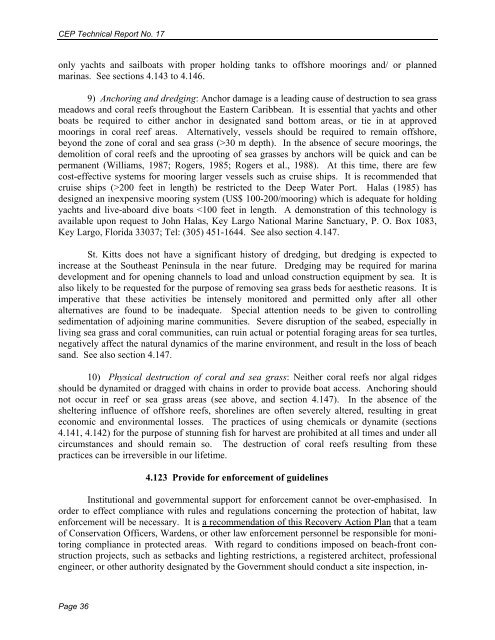Sea Turtle Recovery Action Plan for St. Kitts and Nevis - WIDECAST
Sea Turtle Recovery Action Plan for St. Kitts and Nevis - WIDECAST
Sea Turtle Recovery Action Plan for St. Kitts and Nevis - WIDECAST
Create successful ePaper yourself
Turn your PDF publications into a flip-book with our unique Google optimized e-Paper software.
CEP Technical Report No. 17<br />
only yachts <strong>and</strong> sailboats with proper holding tanks to offshore moorings <strong>and</strong>/ or planned<br />
marinas. See sections 4.143 to 4.146.<br />
9) Anchoring <strong>and</strong> dredging: Anchor damage is a leading cause of destruction to sea grass<br />
meadows <strong>and</strong> coral reefs throughout the Eastern Caribbean. It is essential that yachts <strong>and</strong> other<br />
boats be required to either anchor in designated s<strong>and</strong> bottom areas, or tie in at approved<br />
moorings in coral reef areas. Alternatively, vessels should be required to remain offshore,<br />
beyond the zone of coral <strong>and</strong> sea grass (>30 m depth). In the absence of secure moorings, the<br />
demolition of coral reefs <strong>and</strong> the uprooting of sea grasses by anchors will be quick <strong>and</strong> can be<br />
permanent (Williams, 1987; Rogers, 1985; Rogers et al., 1988). At this time, there are few<br />
cost-effective systems <strong>for</strong> mooring larger vessels such as cruise ships. It is recommended that<br />
cruise ships (>200 feet in length) be restricted to the Deep Water Port. Halas (1985) has<br />
designed an inexpensive mooring system (US$ 100-200/mooring) which is adequate <strong>for</strong> holding<br />
yachts <strong>and</strong> live-aboard dive boats
















